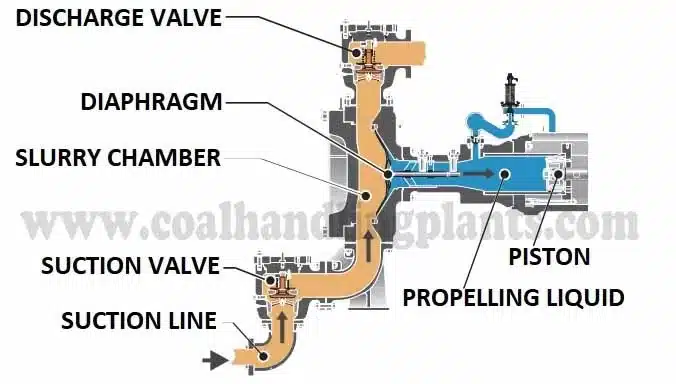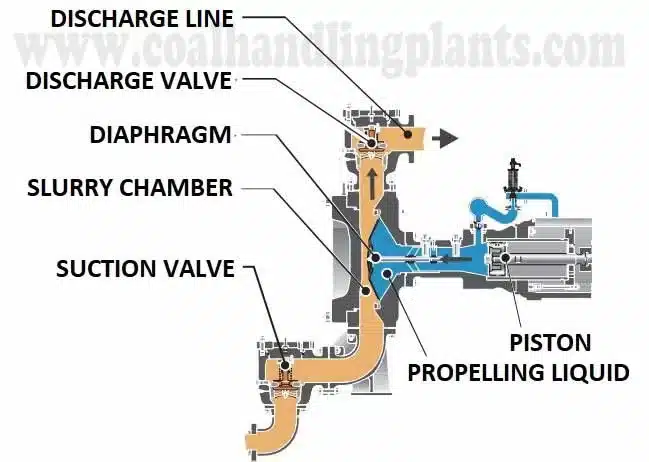The piston diaphragm pump is a reciprocating positive displacement pump designed to handle liquids contaminated with solids like sludge’s, slurry and mud particularly where abrasive or aggressive materials are involved.
A rubber diaphragm separates the pumped liquid from the clean propelling liquid. The pumped liquid has no contact with moving parts such as the piston, the piston rod or the cylinder liner. This enables to use low-wear components to pump at high pressure a solids containing liquid or slurry. The wearing parts subject to exchange regularly are suction valve and discharge valve.
These pumps are capable to handle slurry with solids upto 85% and designed to transport slurry over long distances. GEHO piston diaphragm pump are commonly used in ash handling plant to pump the fly ash or bottom ash slurry to ash dykes.
Working Principle of Piston Diaphragm Pump
Piston moves the propelling liquid to drive the connected diaphragm which then pumps the slurry with 1 revolution of the crankshaft.
Suction Stroke

- The piston moves backward and decompresses the propelling liquid.
- The diaphragm moves backward.
- The resulting low pressure in the slurry chamber forces the discharge valve to close and suction valve to open.
- The slurry fills the slurry chamber of the diaphragm housing unit through the suction line.
Discharge Stroke

- The piston moves forward and compresses the propelling liquid.
- The diaphragm moves forward.
- The resulting high pressure in the slurry chamber of the diaphragm housing unit forces the suction valve to close and discharge valve to open.
- The slurry leaves the slurry chamber through the discharge line.
COMPONENTS OF PISTON DIAGHRAGM PUMP
1. Pump Control System
The pump control system monitors and controls the operation. The pump control system includes:
- A PLC (Programmable Logic Controller).
- The HMI (Human Machine Interface).
The pump control system monitors the pump alarm and trip parameters. It also monitors the pump diaphragm position to prevent an overload of the diaphragm and monitors and controls the load reduction system.
The pump control system allows a local or remote pump start or pump stop procedure as well as the speed control. For maintenance purpose the PLC/HMI allows the manual operation of the propelling liquid fill and outlet valves. If required, then the pump parameters can also be made available to the customer control system.
2. Drive unit
It consists of electric motor, gearbox and coupling. Their function is to provide circular motion to power end.
3. Power end
It converts the circular motion of pump drive into a linear motion of the connected crosshead and piston.
Lubrication Unit
Two lubrication methods are applied: 1 The Splash lubrication. 2 The force feed lubrication system. The Splash lubrication of the crankshaft bearings, affected by their own movement in the oil sump. The force feed lubrication system lubricate points that are difficult to reach by the splashed oil such as the bearings of the drive shaft and the crankshaft, the upper and lower side of the crosshead liners and the crosshead bearings.
Power end cooling system
A separate power end cooling system is installed to cool down the lubrication oil of the power end. A power end cooling pump is installed which pumps the lubrication oil through a heat exchanger . A temperature element is located at the pump oil sump. It activates the power end cooling pump in case the lubrication oil temperature increases above a preset value. The heat exchanger is connected to cooling water. The lubrication oil flows through the heat exchanger and the lubrication oil cools down. A temperature control valve regulates the cooling water flow.
4. Liquid End
The liquid end is divided by a rubber diaphragm into two mechanically separated sections:
- The propelling liquid section
- The slurry section
The propelling liquid section
The propelling liquid section is filled with the propelling liquid. The propelling liquid section consists of:
- The piston unit.
- The rear side of the diaphragm housing unit.
The slurry section
slurry section has contact with the pumped liquid. The slurry section consists of:
- The slurry front side of the diaphragm housing unit.
- The suction valve unit.
- The discharge valve unit.
- 1 Suction air vessel.
- 1 Discharge pulsation dampener.
Piston unit
The piston is connected to the crosshead by means of the: – Crosshead rod; – Connection piece; – Piston rod.
Flushing Unit
The piston flushing unit uses the propelling liquid to lubricate the piston rod and trust piece seals. The propelling liquid for the flushing unit is supplied by the propelling liquid unit. During normal operation the flushing unit is active. If propelling liquid needs to be supplied to the propelling liquid section, then the flow to the flushing unit will be switched off and will be used for the propelling liquid control unit. Logics in the PLC prevent that the absence of propelling liquid in the flushing unit will not exceed 1 minute.
5. Load Reduction System
Purpose of load reduction system is to reduce the load on the piston rod during the discharge stroke by means of oil pressure on the back side of the pistons. By doing so this will increase the load ability of the pump. It has own pressurized oil system. It’s driven by the same motor which also drives the propelling liquid/flushing system pump.
Load reduction system operates separate from the propelling liquid system. It has it’s own small tank and it’s own instrumentation. A small accumulator is installed on top of the block to keep deviations in pressure as low as possible.
It is provided with:
- tank level control
- oil contamination detection
- pressure control
- cooling system
RELATED SEARCHES: